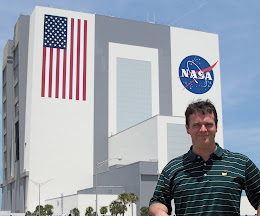 |
| A Russian Soyuz lifts-off with a crew of three to space station. (NASA) |
CAPE CANAVERAL, Fla. -- An American and two Russians lifted-off
into the predawn night sky over Kazakhstan on Wednesday beginning a fast
voyage to arrive at their new home on the ocean of space.
The crew is scheduled to dock with the International Space Station nearly six hours after launch.
NASA astronaut Steven Swanson and Russian cosmonauts Alexander Skvortsuv and
Oleg Artemyev will spend nearly six months living and working aboard
the orbiting laboratory before returning to earth in September.
Stacked fifty meters high a top their Soyuz FG rocket, the crew
awaited the jolt of launch by exchanging comments with Russian mission
control and listening to both classical and current music which echoed
inside their craft during the final hour.
As the countdown clock reached zero, the Soyuz core engine ignited
followed by it's four rocket boosters at 5:17:23 p.m. EDT (3:17 a.m.
local time on Wednesday), accelerating the spacecraft on an easterly
track.
The co-operative mission begins amid growing tensions between the two
countries over the annexation of Crimea by Russia. The United States
and Russia have both placed sanctions on the others leaders.
Western allies, including space station partners Canada and England,
charge that the annexation is illegal, however Russian President
Vladimir Putin confirmed last Tuesday the Black Sea region is under
Russian control and no longer apart of the Ukraine.
NASA administrator Charles Bolden confirmed recently that political
tensions between the U.S. and Russia will not have an ill-will effect as
the crew works 260 miles above the planet.
NASA astronaut Dottie Metcalf-Lindenburger expressed to this
aerospace journalist on Monday her thoughts on how the turbulent
situation on the ground plays out aboard the station.
"Quite frankly, the Russians are our friends when we are on orbit,"
Lindenburger said. "Our countries make political decisions we don't
agree with, but when we (the international partners) are on orbit, we
are colleges and we are friends and we work together, and that is how we
are dealing with it right now."
As the rocket rose from it's launch pad at Baikonur Cosmodrome, a
300-foot golden flame illuminated the black night if only for a few
seconds.
Nine minutes later, the Soyuz craft arrived on orbit as it separated
from the rocket's upper stage to start a nearly four earth orbit chase
of the station.
The Soyuz TMA-12M spacecraft is expected to dock to the space
station's Poisk module at about 11:05 p.m. EDT, as the two crafts pass
over Russian ground stations.
Watching from inside the orbiting laboratory will be Japan's first
space station commander Koichi Wakata, and flight engineers American
Rick Mastracchio and Russian Mikhail Tyurin.
The hatches are expected to open an hour later after the two crews
establish that the Soyuz is completely docked with a good seal.
The newly united crew of six will begin a busy week on Monday as they
prepare for Wednesday's grapple and docking of the commercial SpaceX
cargo craft known as Dragon.
Loaded with 4,600 pounds of fresh supplies and hardware, Dragon is
poised atop a SpaceX Falcon 9 rocket at Cape Canaveral for it's planned
Sunday evening launch. Dragon's five second launch window is targeted
for 10:50 p.m.
Swanson, a father of three and a four time spacewalker, will serve as
the space station's commander beginning on May 13, as Wakata and his
crew depart the outpost in their own Soyuz for the trip home.
A two time space shuttle astronaut, Swanson's last trip to station
was exactly five years ago as his crew delivered the starboard truss
segment, a set of solar arrays and batteries to increase the lab's
power.
"Steve's been training for two and a half years for this mission,"
Metcalf-Lindenburger said. "He has also had some shuttle flights so this
should really be a good experience to have Steve on orbit. He's a great
space walker and he'll lead with great confidence."
During Swanson's tenure as commander, the International Space Station
will mark a milestone on July 11 as it celebrates the 5000th
consecutive day in which it has been manned by a crew.
The occasion will be marked by the station's crew in a brief ceremony recognizing the special milestone.









